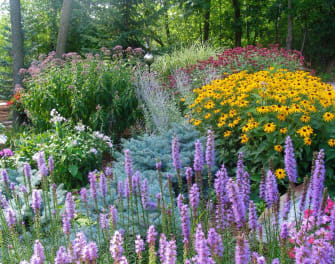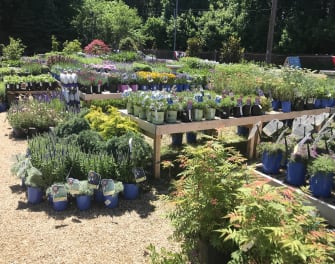Unlike annual flowers and plants, perennials will return and bloom every year for at least two years as long as they are properly cared for and maintained. Although flowering perennials typically die back in winter when the frost hits, they will be reborn like a phoenix during spring. Fortunately, many perennial’s root systems are tough enough to survive cold weather, making them a popular choice among gardeners of various zones and climates.

Benefits of Perennials
Cost-Effective
Perennials hold some clear advantages over annuals. They are definitely more cost-effective in the long run. Because perennials grow back year after year, you can look forward to saving quite a bit of money over time. This is especially good news for gardeners who take pride in being thrifty. When purchasing perennial seeds, your investment will quickly start to pay off.
Less Maintenance
While gardening always requires some maintenance, perennials shouldn’t demand too much time and effort. Caring for perennials generally requires far less work than their annual counterparts. You won’t have to worry about clearing flowerbeds and sowing seeds every spring. Furthermore, perennials are easier to keep healthy. Because these plants have deeper root systems, they can better withstand powerful windstorms and floods. Once perennials are established, growers can sit back and enjoy the fruits of their labor.
Need Less Water
During the summer, it’s not uncommon to experience a drought. Shallow roots make annual plants more likely to wilt in dry conditions. Perennials are noticeably more resilient to droughts. Their roots stretch down far below the soil’s surface. Even when the weather starts to dry up, they can draw up water from lower in the soil profile. You can take a weeklong vacation without worrying about the conditions of your plants.
Better for the Soil
Perennials can actually improve the condition of your garden’s soil. While growing, they effectively aerate the ground. This creates additional channels for water to flow. Erosion is also far less likely to occur. Because the soil’s structure is preserved, nutrients can’t easily wash away. There will be an ample supply of fresh oxygen and moisture, which helps the whole garden to thrive.
Keeps Away Weeds
As a gardener, you already understand the trouble weeds can cause. If you aren’t careful, they can take over your entire flower bed. These invasive plants sap nutrients from the soil, thus making it more difficult for other vegetation to grow. Planting perennials can help keep away weeds. The strong roots of a perennial flower limit the space where weeds can spread. This means you won’t have to overwork yourself by constantly pulling weeds.
Variety is the Spice of Life
While annual flowers can have a beautiful appearance, they tend to all bloom within the same period. Meanwhile, perennials bloom at various times. Your garden will thrive with a variety of different colors throughout the entire warm season. This creates a stunning spectrum that catches everyone’s attention.
Less Planning Needed
Perennials enable you to avoid the hassle of planning for the next year. While you can always add new flowers, the primary design of your garden will already be set. When the spring comes around, you'll be one step ahead of the game.

Perennial Selection at Decker’s Nursery
You will be more than impressed, you will be DAZZLED by our perennial selections. Our expertise in perennials is unmatched and that’s why you should start your project at Decker’s Nursery. Perennials are sensitive to their location and environment. Using the right plant in the proper location will assure a spectacular result. We display perennials according to their bloom period (4 to 6 weeks). You can rely on us to help you create a magnificent rotational display of color at your home and in your gardens.
Frequently Asked Questions
Perennial Flowers & Plants FAQs
As you plan your landscaping, you want a space that is filled with gorgeous color from spring to fall. The best way to accomplish this is by choosing flowers that bloom at different times of the year with a mixture of annuals and perennials throughout your flower beds. By knowing the difference between these types of plants and understanding how to care for long-lasting perennials, you can create a gorgeous and welcoming yard.
What is the difference between perennials and annual flowers?
Perennials are flowering plants grown from bulbs or seeds that live for at least three years. Although they may only bloom for a season, they come back to life the next year after a period of dormancy throughout the cold winter. On the other hand, annual flowers only last for one year and are not hardy enough to survive the winter.
Some flowers can be either perennials or annuals depending on the zone in which you live. While much of New York rests in cooler zones, Long Island is listed as Zone 7, giving you a wider array of long-living perennials for your yard. At Decker’s Nursery, our gardening experts are more than happy to show you which flowering plants are hardy enough to live in your garden for years.
What are some of the most popular perennials?
While there are quite literally hundreds of perennials that grow all across the world, some of them are incredibly popular among average homeowners because of their beautiful colors and simple care needs. In fact, some, such as the daylily, need virtually no assistance during the growing season and only require dead flower heads to be removed at the end of the year.
Some of the options you will most frequently see in flower gardens throughout Long Island include the following:
- Daylilies
- Hostas
- Catmint
- Salvia
- Shasta Daisies
- Coneflowers
- Phlox
- Black-Eyed Susans
- Clematis
- New England Asters
- Tickseed
What is the longest blooming perennial?
Many perennials bloom only for a few weeks out of each year and must be mixed with other flowering plants if you are looking for long-lasting color from spring through fall. However, certain varieties take the confusion out of landscaping design by blooming for a much longer period. The following options are easy to grow and require little maintenance thanks to their long blooming periods.
- Catmint “Walker’s Low”
- Bleeding Heart “Luxuriant”
- Ornamental Onion “Millenium”
- Coneflower “White Swan”
- Yarrow
- Garden Phlox
- Stella de Oro Daylily
- Russian Sage
- Butterfly Bush
- English Lavender
What perennials do well in shade?
It may seem as if the majority of flowering perennials love the sun with the brightest blooms and boldest colors devoted to areas that enjoy six or more hours of sun every day. However, a shady garden can still be quite lovely with plenty of hues of green foliage and a few unique blooms. These particular examples will do quite well in partially shady areas of your garden that get only three to four hours of sunlight every day.
- Astilbe
- Foxglove
- Epimedium
- Primrose
- Bleeding Heart
If you have an area that is constantly in the shade, there is still hope for a gorgeous garden with these varieties.
- Coral Bells
- Lungwort
- Hosta
- Astilbe
- “Jack Frost” Heart-Leaf Brunnera
Can perennials survive through winter?
The beauty of perennials is that they safely become dormant over the winter and magically return to life the next spring. However, if you want to see your favorite plants bloom again, you must treat them with care to protect their roots. Some perennials are particularly hardy and will need virtually no help from you.
Other perennials that are not quite as hardy for your zone or that are planted in pots will need a bit more attention. For those planted in the ground, you will want to cut back foliage and stems, work in compost around the roots and replace old mulch with fresh hay after the first frost. If you have perennials planted in pots, consider digging a hole in the ground that is large enough for the pot to protect the roots, or bring the pot inside to winter with you. Our plant nursery has a variety of pottery that will look great indoors and out.
What are some hardy perennials?
If you prefer to spend less time in your garden during the fall to get your plants ready for the winter, consider investing in hardy perennials that will come back to life in the spring with virtually no help from you. Plus, they can stand up to the harshest Long Island winters.
- Yarrow
- Hostas
- Daylilies
- Shasta Daisies
- Hollyhock
- Columbine
- Salvia
- Bugleweed
- Coreopsis
Which perennials are best for my Greenlawn, NY garden?
When planting perennials, it is important to consider your climate, your gardening space and your soil. Without the right combination of these, your garden runs the risk of looking sparse or flowerless. While begonias, geraniums, impatiens and petunias are some of the best-growing annual flowers on Long Island, you also have a long list of dependable perennials from which to choose on your next trip to the nursery. Hostas, toad lilies and Korean tassel ferns do particularly well in shady spots. Of course, you will have more choices for sunny spots, including bright blanket flowers, gorgeous peonies and salvia that comes in a wide range of shades and varieties.
When should I plant perennials?
Planting your perennials at the right time will ensure that they continue to bloom for years. Although the majority of perennials should be planted or divided in the spring when the ground has thawed and sunny days become longer, a few options should be planted in the fall. For example, fall is an excellent time to plant bulbs that bloom in the spring and summer. You can check Decker’s Nursery throughout the year to see which in-season bulbs are currently in stock.
The two seasons when you should never plant perennials are summer and winter. During the summer, the weather is too hot and the sun is too strong to allow tender, young roots to adjust. Of course, the ground is usually frozen and completely inhospitable to bulbs, seeds or plants during the winter.
How should I care for perennial plants?
Other than the few particularly hardy plants that will continue to grow without any help from you, the majority of perennials need some level of regular care to flourish. Some of the regular care steps you will take should include watering, feeding, deadheading and mulching.
- If the summer is particularly dry, you may need to give your perennials an occasional good soaking at the roots.
- Fertilize your perennials in the spring with a low-nitrogen variety, and add compost around the roots in the fall.
- Remove dead flower heads to help your plant create new blooms.
- Mulch around your plants to protect the roots, improve moisture content in the soil and reduce the growth of weeds.
Where’s the best place on Long Island to buy perennial flowers and plants?
Decker’s Nursery, located Greenlawn, NY on Long Island, is your clear choice when it comes to buying healthy perennials for your garden. Not only do we have dozens of choices for gardeners of all experience levels, but also we have experts on hand to give you pointers for planting and caring for your new flowers. When you head to our full-service nursery & garden center, you are sure to have an unparalleled experience and will certainly come away with a gorgeous selection for your container garden, landscaping project or border.
